BaseFEX Exchange Review

BaseFEX is a secure and reliable modern derivatives platform to trade perpetual contracts for Bitcoin, Ethereum and other popular altcoins, with maximum 20x ~ 100x leverage.
BaseFEX is a cryptocurrency derivatives exchange where traders can successfully place orders under any market condition. BaseFEX is developed by professionals using cutting-edge technologies from the ever-evolving internet industry, which outperforms decades-old technical solutions commonly used in the financial industry.
BaseFEX’s mission is to be the most reliable, transparent and advanced cryptocurrency derivative exchange, and make trading smooth, secure and accessible for traders worldwide.
BaseFEX has the mission of being the most transparent, advanced, and reliable crypto derivatives exchange. BaseFEX has its team based out of Hong Kong. It is registered, however, in the Republic of Seychelles. There, it is known as Base Investing Corporation and has company number 205276.

BaseFEX is one of the newer platforms for this area of Crypto trading, so how does it stand up? Let’s take an in-depth look in our BaseFEX review.
Trading Screen
The Trading screen on BaseFEX has a similar layout to other platforms so you should feel right at home. The left side of the page lets you select the asset and contract type. There are tabs for USDT settled and BTC settled. Below these, you can view all the cryptocurrencies available as pairs, each with their last price and percent change.
When you are logged into BaseFEX, below this you will see your positions for the selected pair. Under this, you can see your balances in BTC.
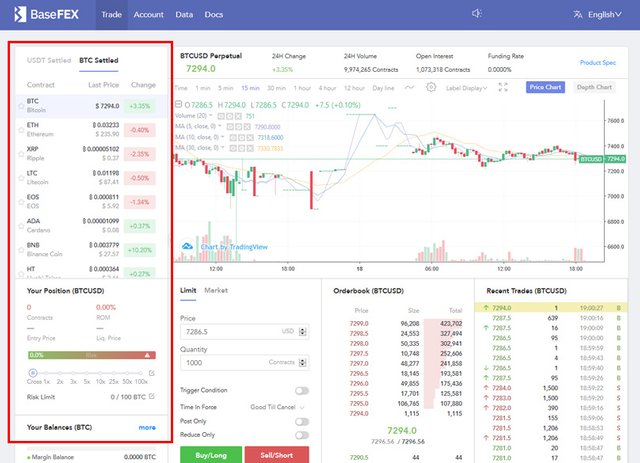
The right two-thirds of the page above the fold are dedicated to the trading graph. Just above the graph, you can see the asset and its change in both BTC and USD. To the right of this is the 24-hour change, 24-hour volume, open interest, and funding rate. Clicking on the Product Spec button to the right of this will take you to the Perpetual Contract Specification page.
The graph itself can be adjusted to meet your needs. The price chart is default or you can switch to a depth chart. The time intervals can be 1, 5, 15, or 30 minutes; 1, 4, or 12 hours; or a day. To the right of these options, you will see indicators, settings, and a full-screen option.
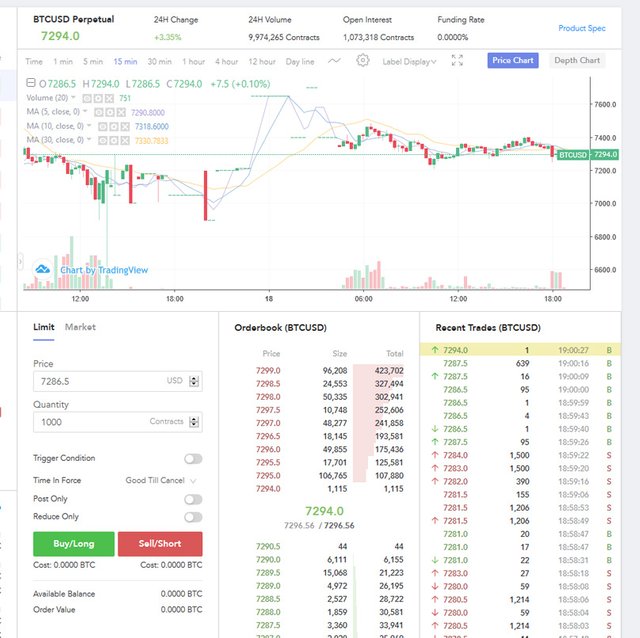
Immediately above the graph, you will see open, high, low, and close values for the specific point you hover over. The default display of the graph is with candlesticks and hovering over a point shows your specific data.
Order Placing
Immediately below the left side of the graph, you will see the basic order form. You can enter quantities and prices and choose between Limit and Market orders. Enter the relevant information and select Buy/Long or Sell/Short. You will view updated details on costs for each action, order value, and available balance.
When you want to place an order on BaseFEX, start by going to the Trade dashboard. There, you can choose either the Sell/Short or Buy/Long button. The system will always automatically confirm you have sufficient balance available to maintain your initial margin.
In the case of existing positions, the system also automatically confirms that your available balance covers changes to maintenance margins. It will also confirm you can cover the PNL. The order then gets placed assuming you have sufficient funds. Keep in mind that if you have a net active order that is not canceled or filled, it is accounted for. This will reduce your available balance by the net orders’ initial margin.
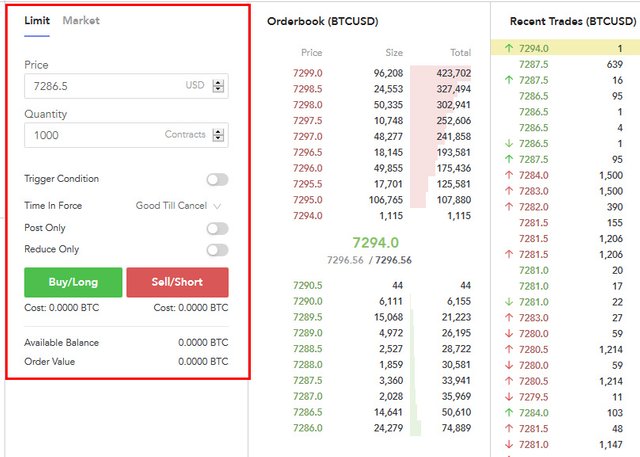
Just to the right of this is the orderbook for your given trading pair. This is color-coded and divided into Buy/Long and Sell/Short. For each, you can see the price, size, and total. To the right of this is the recent trades for the pair. These are in order based on time. They all show price, size, time, and whether it was a Buy or Sell. They are also color-coded green or red based on whether they are Buy or Sell.
Below the graphs and order books on the Trade page, you can view your open positions when logged in. You will see specific details for each position, including values and times. Below this, you can see the orders you have for the current pair, including active orders and order history. These are divided into buys and sells. They include order value, size, price, type, average price, status, time, and whether they are filled.
Indicators
To use indicators, click on the wavy line above the graph on the BaseFEX trading page. Here, you will find several dozen indicators to choose from. You can either scroll through the options or search via text. Just some indicators include Aroon, Average True Range, Balance of Power, Bollinger Bands, Chop Zone, Connors RSI, and EMA Cross. Others include Know Sure Thing, Money Flow, Moving Average, Price Oscillator, and more. There are over 50 available indicators in total.
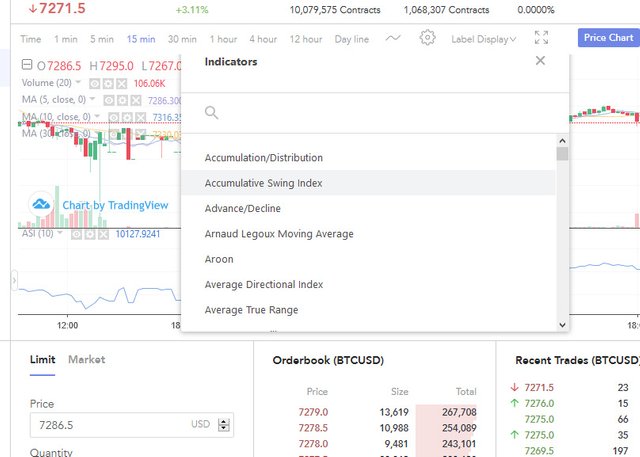
Graph
The Settings adjustments for the Trade section on BaseFEX is divided into Style, Scales, Background, and Timezone/Sessions. Style includes choices like candle colors, borders, wicks, and scale location. Scale options include placement, types of scales, margins, and decimal places. Background options include indicator arguments, titles, and values, bar change values, patterns for lines, and more. Timezone/Sessions options are just the time zone and your choice of session breaks.
Order Types
There are several different order types available from BaseFEX, each related to trading crypto derivatives. Market orders are executed immediately using the market price at the time of the order. This is an ideal order type for those who want to urgently execute their order. For market orders, users just input the quantity.
Limit orders let you specify the minimum or maximum you will sell or buy at. This is a good method of minimizing the costs of trading. It can also, however, lead to unexecuted orders or orders that take a long time to execute. This happens if your price is far from the market price.
Margin
BaseFEX clearly outlines the initial margin requirements in the Doc titled How to Trade. In the case of Buy/Long orders, the initial margin is the IM x Contracts x Limited Bid Price x Multiplier. BaseFEX reserves the commission with the limit bid price. The actual commission you will pay gets calculated once the final execution takes place as it is based on that price.
In the case of Sell/Short orders, your initial margin is IM x Contracts x Max (Limit Offer Price, Best Bid) x Multiplier. As with Buy/Long orders, the commission for Sell/Short orders gets calculated using the execution price. In the meantime, BaseFEX reserves it with the best bid or limit offer price for a contract, whichever is higher.
Keep in mind that BaseFEX does not charge an initial margin in cases when the order reduces position sizes. In the case of both Sell/Short and Buy/Long orders, the calculations change slightly. The initial margin is just charged on net Buy/Long orders, based on Buy orders minus Sell orders. If the Sell/Short orders do not reduce the current size of a position, they still get charged the initial margin.
Initial margin calculations are also slightly different in the case of contracts with Fair Price Marking. You must fund any difference between your mark price and order price. This applies if the Sell/Short order is below a mark price or a Buy/Long order is above it.
Maintenance margin calculations depend on Mark Prices for contracts. Regardless of position, Maintenance Margins are equal to MM x Contracts x Mark Price x Multiplier. The maintenance margin requirement also adds the required commission for closing all positions. This figure is the minimum margin you have to maintain if you do not want your position to be liquidated.
Liquidation
It is possible to leverage the perpetual contracts on BaseFEX as much as 100x. In order to keep the positions open, you have to hold a percentage of the position’s value, known as the maintenance margin. If you do not have the maintenance margin, then you lose this maintenance margin and are liquidated.
At any point, you can view the liquidation price of positions via the Open Position tab. This page also lets you adjust the liquidation price indirectly via adjusting the risk limits or leverage sliders.
BaseFEX takes steps to minimize liquidations due to market liquidity and price manipulation. This includes the use of the Fair Price Marking mechanism. That mechanism involves setting Mark Prices of contracts to Fair Prices instead of using Last Prices. To further minimize liquidations, BaseFEX requires higher margin levels for bigger positions due to risk limits. The liquidation engine requires additional margin for closing large positions.
In the case of large positions that need to be liquidated and closed, this is done gradually to minimize the market impact. After a liquidation, BaseFEX cancels open orders that are part of the current contract. This process will release the margin so you can keep the position. Orders from other contracts do not see any changes.
Liquidation Process
The liquidation process on BaseFEX varies slightly based on whether you have low or high-risk limits. In the case of low-risk limits, BaseFEX will cancel every open order within a contract. The liquidation engine will liquidate the position using the bankruptcy rate if you cannot fulfill the maintenance margin.
If you have a high-risk limit, then the liquidation system attempts to change the risk limit, lowering it. From there, it reduces requirements for the maintenance margin in several ways. One method is to lower the risk limit to maintain the current position and order. Another is to cancel open orders before lowering the risk limit so it matches your current position. Or BaseFEX’s system may submit a Fill or Kill order. This would use the difference between the position size of your current risk limit and that which would meet the margin requirement.
If all of those methods fail and the liquidation risk remains, then the liquidation engine acts. That engine will close the position using the bankruptcy price. If BaseFEX can liquidate positions at prices better than those of bankruptcy, extra funds go to its Insurance Funds. In cases where BaseFEX cannot liquidate positions at this bankruptcy rate, Insurance Funds are used to close the position. Auto-Deleveraging will get triggered if the position is still unable to be liquidated.
Funding and Settlement
Any perpetual contract you open at BaseFEX will be subject to funding. There is specific information for each perpetual contract in the funding history and contract specifications. Positions close at settlement prices at the time of the settlement. Perpetual contracts never settle, so there are no settlement fees to pay. In the case of an expired contract, the contract’s lifetime loss and profit get factored into your Bitcoin balance. The contract will not appear in your position section anymore for expired contracts. Keep in mind that any BaseFEX calculation is final.
Deposits & Withdrawals
Making a deposit to a BaseFEX account is very straightforward. You just visit the Accounts tab and then select Deposit. You will see a multi-signature wallet address. Send the funds you want to deposit to this address. Following one confirmation, the funds get credited to your BaseFEX account. There is not a set minimum deposit amount for BaseFEX accounts. Instead, it depends on initial margins.
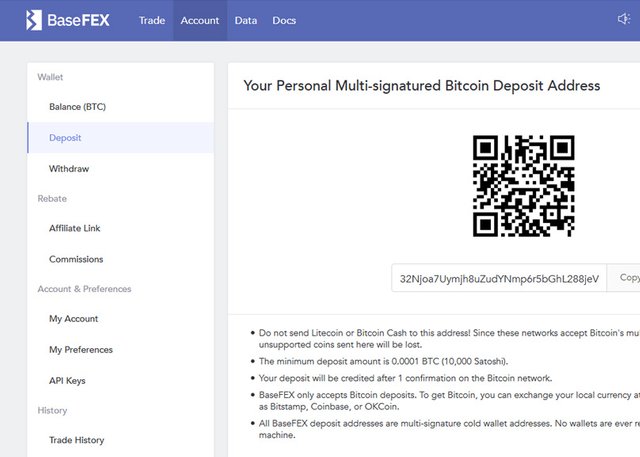
Withdrawals are done in a similar manner, via the Accounts tab of BaseFEX. The platform processes all Bitcoin withdrawals before 7:00 UTC+00 daily. Those who initiate a withdrawal will have Bitcoin sent to their addresses soon after that time.
Fees
BaseFEX clearly outlines all of its fees on its website via the Fees page. This page features a list of all perpetual contract pairs and the fees in percentages. Fees are listed for makers, takers, long funding, and short funding. The funding interval is each eight hours for every perpetual contract.
At the time of writing, the maker fees are always 0 percent. The taker fees are either 0.2 percent or 0.05 percent, depending on the contract. Long funding varies between -2.981 percent and 0.3000 percent while short funding varies between -0.3000 percent and 0.2981 percent. The negative fees indicate rebates. There is a note on the Fee page that the funding rates will change depending on the market’s lending rates.
There are no fees for making deposits or withdrawals with BaseFEX. The only fee that applies, in this case, will be the Bitcoin network fee, of which none goes to BaseFEX. It is important to note, however, that BaseFEX handles the withdrawals of these fees and withdraws the maximum initially. The platform takes care of these in batches, then optimizes them. This can result in saved fees, which are then refunded. There are also no fees for funding received or paid from BaseFEX.
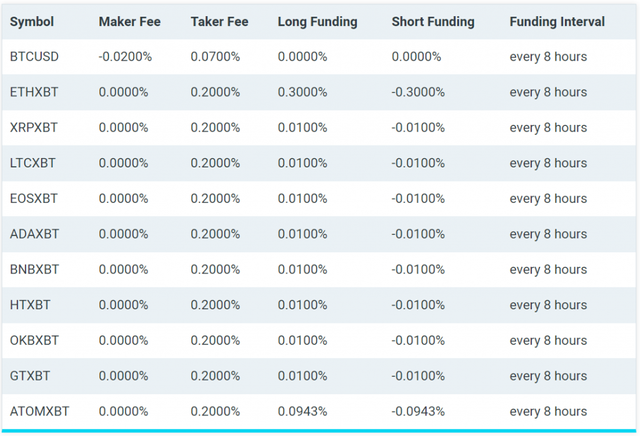
Discounts on Fees
There is a discount fee policy from BaseFEX for those who are big traders. To qualify, an account must have a total order value in seven days of over $35 million USD. This entitles the account to a discount of 50 percent on commission fees.
Funding Rate Caps
BaseFEX does have funding rate caps, which you can view on the Perpetual Contract Overview in the Docs section. The absolute funding rate caps at 75 percent of the value of the initial margin minus the maintenance margin. It will never change by a value greater than 75 percent of a maintenance margin between various funding intervals.
Contracts
If you visit the Docs section of BaseFEX, you can view the contract specifications for each perpetual contract offered. There are separate pages for each: BTCUSD, ETHXBT, XRPXBT, LTCXBT, EOSXBT, ADAXBT, BNBXBT, HTXBT, OKBXBT, GTXBT, and ATOMXBT.
Each of these contract specification pages is laid out similarly. They begin with an overview that indicates the index that the pricing is based on. In the case of BTCUSD Perpetual Contracts, this is the BFBTC Index. They also indicate how much each contract is worth, typically 1 of the quote currency in the base currency. The base currency is the first part of the contract name while the quote currency is the second. For example, each BTCUSD Perpetual Contract is worth a single USD of BTC.
The overview also indicates funding frequency and the next time. There is then a statement that as a perpetual contract, it never expires. There is also an explanation of using a Premium Index for funding rates.
Below this, each page displays a chart that indicates the funding calculations. It includes rates for interest base, interest quotes, and premium. These are BTCBON8H at 0.00 percent, USDBON8H at 0.00 percent, and BTCUSDPI8H at -0.17 percent, respectively, for the BTCUSD at writing. Under the chart, there is also a brief explanation of Funding Rate and Premium Rates plus relevant formulas.
The last section of each perpetual contract specification page is the full contract details. Here you can find the symbol, expiry date (perpetual), initial and maintenance margins, funding rates and intervals, and mark price. It also lists the fair basis rate, basic risk limit, contract size, and more. For BTCUSD, for example, the minimum price increment is 0.5 USD with a max price of 1 million USD.
Security
BaseFEX prides itself on utilizing top security practices. These include storing 100 percent of assets in cold wallets with multi-signatures. Overall, BaseFEX has a commitment to platform and user security. The platform takes conservative and rigorous security measures, never compromising security to maximize convenience. Additionally, BaseFEX has a bug bounty program to encourage users to report any security issues that they find. This allows the problem in question to be addressed immediately.
As mentioned, all assets found on BaseFEX get stored in cold wallets with multi-signatures. Additionally, every single BaseFEX address is multi-signatured. All of the storage remains offline at all times.
The setup of the wallets on BaseFEX means that even if the entire system was compromised, the funds would remain safe. That security comes from the fact that an attacker would not have enough keys to be able to steal funds. They could not even get enough keys if the database, trading engine, and web servers were all compromised. Since that situation is highly unlikely, the storage is even safer.
BaseFEX also takes additional security precautions in regards to withdrawals. Every single withdrawal gets audited by hand. This is done by a minimum of two employees at BaseFEX before the withdrawal is sent. For the majority of funds, there are no private keys stored on any cloud servers. Additionally, BaseFEX uses deep cold storage for most funds.
Security for deposits includes verifying all deposit addresses the BaseFEX system sends. This is done via an external service and allows for assurance that the addresses contain the keys that the founders control. In the rare case that a public key does not match, the system will shut down immediately. This includes all trading is halted.
Wallets
As mentioned, BaseFEX stores Bitcoin in a wallet that uses cold storage and is multi-signatured. Cold multi-signatured wallets store Bitcoin offline. They additionally require several signatures for any transactions to take place. Before an expense on BaseFEX takes place, five out of the seven partners must sign for the transaction.
The use of a multi-signature address was intentional to improve security. It helps prevent theft of funds, providing security of user funds.
BaseFEX uses its own platform, which you can access online via the website or via the mobile application. The application is fully featured, allowing for trades and more. You can download it via the QR code on the appropriate page of the BaseFEX website.
Market Disruption Events
If a market disruption event (MDE) occurs, BaseFEX has a system in place. This MDE can occur if there is an outage on an exchange that affects the Index Price. If BaseFEX declares an MDE, it will inform clients about any changes to expiry or settlement dates of affected contracts. This is done via email as well as an MDE declaration on the BaseFEX Trade dashboard. BaseFEX has full discretion when declaring an MDE, with all decisions being final.
Affiliate Program
There is an affiliate program from BaseFEX, as is expected from a platform of this sort. The affiliates in the program receive payouts of partial commissions from their referrals. These payouts continue for life, lasting as long as the referral continues to use BaseFEX. The percentage of the commission that the affiliate receives depends on the referrals’ Bitcoin turnover. The minimum affiliate payout is 20 percent of the commission profit. For a total of over 1,000 BTC notional traded on referrals, the percentage increases to 30 percent. It goes up to 40 percent for amounts over 10,000 BTC.
The referrals also receive benefits in the form of a limited-term discount on fees. Clients of BaseFEX that sign up using an affiliate link get a 10 percent discount on commissions for a total of six months. The discount will apply across all contracts.
FAQ
Like most similar platforms, BaseFEX does indeed have an FAQ page. Instead of solely focusing on using the platform, however, it also includes some basic education. The first half or so of the FAQ page is dedicated to explaining concepts related to perpetual contracts. There are definitions of futures and perpetual contracts as well as mark prices. There is also information on how BaseFEX calculates settlement prices and perpetual contract prices.
The FAQ page then has a section dedicated to leverage, including explanations of terms like initial and maintenance margin. The next section focuses on liquidation, explaining how and why it happens. There are also explanations of insurance fraud, Auto-Deleveraging, and related concepts.
At this point, the FAQ section of BaseFEX turns more toward traditional queries you would expect. There are clarifications related to fees, including the lack of fees for deposits and withdrawals. This section also explains the possibility of Bitcoin Network fee refunds and the BaseFEX trading fees.
The FAQ page on BaseFEX concludes with details about deposits and security. This includes how to deposit, minimum amounts, wallet information, and support.
In addition to the brief definitions and descriptions in the FAQ page, BaseFEX also offers some other educational information. If you visit the Docs section for Contract Specifications, you will find detailed descriptions for futures and perpetual contracts.
The Futures Contract Overview section explains what futures contracts are, including the ability to use leverage with them. It also goes into detail about the key mechanisms within the futures market, providing definitions for each. These include multipliers, position marking, maintenance and initial margin, basis, and settlement.
The Perpetual Contract Overview section provides similar information but for perpetual contracts. This includes an overview of the main difference between perpetual and future contracts, meaning the lack of expiry date and settlement. It also explains the funding rate. There are also explanations for market features, including position marking, maintenance and initial margins, funding, and funding timestamps.
This page additionally includes a description of funding and its timing on BaseFEX. It includes the equation for calculating funding, position value x funding rate plus an example calculation. There are further calculation explanations and examples for interest rates and premium/discounts as part of funding rate calculations. This is followed by an example of the final funding rate calculation. It concludes with explanations of funding rate caps, the lack of BaseFEX funding fees, and further examples.
To further extend the educational content available on BaseFEX, the platform also has a Reference section. This is within the Docs tab and has descriptions for Isolated and Cross Margins, Order Types, and Fair Price Marking. There are also descriptions for Auto-Deleveraging, Profit and Loss, Risk Limits, and Margin Terminology.
Each of those sections has its own page with details. There are brief overviews of the relevant terms and concepts at the top of the page, followed by more in-depth explanations. In the case of terms related to calculations, BaseFEX includes both the formulas and examples.
Support
BaseFEX gives clients multiple methods of contacting customer support. Many answers can be found in the FAQ section of the website so contacting BaseFEX is not even always necessary. When you do need support, it is available 24/7. This can be done via email, Telegram, and Twitter. There is no support phone number listed on the BaseFEX website, which some may see as a lack.
API
BaseFEX has an API available via GitHub, with a link to it on the bottom of the main BaseFEX page. This will take you to the fully-featured REST API and the streaming WebSocket API. Developers are free to use these API resources.
Conclusion
BaseFEX provides clients a way to trade cryptocurrency derivatives in a simple manner. Trading can be done online via the website which is simple and well designed.
There are 11 Perpetual Contracts available for trade with BaseFEX, as well as Futures Contracts and the amount of leverage offered is high (100x).
The fees are very reasonable, no charge for deposits or withdrawals and makers fees are free with takers fees being 0.05%.
BaseFEX is a newer trading platform so hasn’t had time to build a good reputation online yet, it’s up against some solid competitors in BitMex, PrimeXBT, and Deribit so it will need some time to establish itself. In this area of trading, trust is a valuable part of the business – you need to know that there is nothing shady going on behind the scenes when using leverage as liquidation can cost you dearly.
We did like the trading screen which well designed, easy to use and fully featured, including indicators and multiple chart types. Lack of a dedicated mobile app lets it down slightly but the exchange is usable on mobile if a little fiddly.
Posted from Cryptotreat Cryptotreat : https://cryptotreat.com/basefex-exchange-review/
Warning! This user is on our black list, likely as a known plagiarist, spammer or ID thief. Please be cautious with this post!
If you believe this is an error, please chat with us in the #appeals channel in our discord.